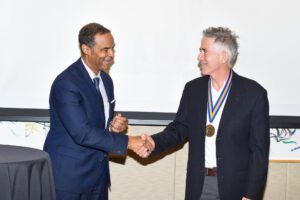Wei Lu talked about his innovations as the 2022 Distinguished University Innovator, followed by a panel discussion about the University’s role in fueling new high tech companies in the area.


Wei Lu talked about his innovations as the 2022 Distinguished University Innovator, followed by a panel discussion about the University’s role in fueling new high tech companies in the area.
Mechanical engineers at the University of Michigan are tackling mysteries of bone density loss in space and on Earth.
The post Gravity’s impact on bone cells—experiments heading to the International Space Station appeared first on Michigan Engineering News.

Flynn is one of the world’s premier scholars of analog and mixed-signal integrated circuits and systems, analog-to-digital conversion (ADC), and other interface circuits.
A collaboration between engineers and experts from the U-M Center for Social Solutions to address inequity in flood recovery.
The post Video: Creating Equity in Midwestern Flood Response and Recovery appeared first on Michigan Engineering News.
Rudra works in the area of solid-state and nanotechnology, and has managed to acquire a broad range of experience in different research settings
The post Kamal Rudra receives IEEE EDS Masters Student Fellowship appeared first on Michigan Engineering News.
With election security experts waylaid by years debunking false claims of election fraud, little has improved since 2020.
The post Expert: 4 ways Americans can keep their vote secure and accurate appeared first on Michigan Engineering News.
Up to 60 researchers who have expertise outside of computer science will be trained at the Michigan Institute for Data Science, contributing to a global cohort of interdisciplinary AI researchers.
The post U-M, Schmidt Futures partner to launch new AI postdoctoral research program appeared first on Michigan Engineering News.
The cohort of 36 new tenured and tenure-track faculty includes 11 faculty hired at the rank of professor or associate professor.
The post Senior hires stand out in an impressive year for faculty hiring appeared first on Michigan Engineering News.
Roberts’ work could help improve the management of corn fields, which is important for food production, biofuel, and industry raw material.
The post Kaleo Roberts receives AISES scholarship for research on monitoring corn fields using remote sensing appeared first on Michigan Engineering News.
Concrete and construction aggregates could be carbon negative and dollar positive while sustainable aviation fuel and methanol could also turn a profit.
The post Carbon capture, utilization and storage roadmap reveals technologies that are ready to go appeared first on Michigan Engineering News.